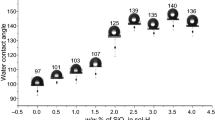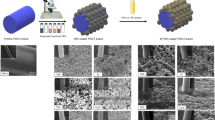Abstract
Biofilms are a critical health concern because of their ability to render tolerance and resistance against antimicrobials, which is especially challenging for surgical-site sterility and surgical wound recovery. Development of biofilm-inhibiting coatings on surgical devices could aid to limit biofilm formation at surgical site. In this context, two biofilm-inhibiting nanocomposite hydrophobic coating formulations, one with biocide and the other without biocide, were developed and deposited on various substrates such as glass, plastics, and surgical sutures, followed by biofilm inhibition evaluation. Encouraging results were obtained and reported earlier. In the present study, the biofilm-inhibiting action of coatings on surgical sutures was re-examined using a spot assay method by counting the colony-forming units. The long-term durability of the coated sutures with respect to varying temperature, humidity, inflammatory cytokines, and body fluid was studied, in order to validate their suitability for use in surgical accessories and biomedical devices. RTPCR test was carried out to look for downregulation of biofilm-forming genes. Cytotoxicity of the nanocomposite coatings was examined by carrying out an MTT assay. The downregulation of biofilm-forming genes and minimal cytotoxicity of the nanocomposite coatings further confirmed its viability for using on surgical sutures. Overall, the current study provides mechanistic insights and additional bactericidal effect of the hitherto demonstrated antibiofilm activity of the formulation. This study also establishes long-term durability of the coatings in terms of temperature, humidity, and exposure to plasma, enabling its use in surgical accessories to be commercialized in various settings.













Similar content being viewed by others
References
Cloutier, M, Mantovani, D, Rosei, F, “Antibacterial Coatings: Challenges, Perspectives, and Opportunities.” Trends Biotechnol., 33 (11) 637–652 (2015)
Weatherly, LM, Gosse, JA, “Triclosan Exposure, Transformation and Human Health Effects.” J. Toxicol. Environ. Heal-Part B, 20 (8) 447–469 (2017)
Ferdous, Z, Nemmar, A, “Health Impact of Silver Nanoparticles: A Review of the Biodistribution and Toxicity Following Various Routes of Exposure.” Int. J. Mol. Sci., 21 (7) 2375 (2020)
Srinivasan, R, Santhakumari, S, Poonguzhali, P, Geetha, M, Dyavaiah, M, Xiangmin, L, “Bacterial Biofilm Inhibition: A Focused Review on Recent Therapeutic Strategies for Combating the Biofilm Mediated Infections.” Front. Microbiol., 12 676458 (2021)
Soule, LD, Pajares, CN, Chuong, K, et al. “Sol-Gel-Derived Bioactive and Antibacterial Multi-Component Thin Films by the Spin-Coating Technique.” ACS Biomater. Sci. Eng., 6 (10) 5549–5562 (2020)
Perera-costa, D, Bruque, JM, González, ML, Gómez-García, AC, Vadillo-Rodríguez, V, “Studying the Influence of Surface Topography on Bacterial Adhesion Using Spatially Organized Microtopographic Surface Patterns.” Langmuir, 30 (16) 4633–4641 (2014)
Zhang, X, Wang, L, Levänen, E, “Superhydrophobic Surfaces for the Reduction of Bacterial Adhesion.” RSC Adv., 3 (30) 12003–12020 (2013)
Li, Y, Kumar, KN, Dabkowski, JM, et al. “New Bactericidal Surgical Suture Coating.” Langmuir, 28 (33) 12134–12139 (2012)
Liu, L, Ercan, B, Sun, L, Ziemer, KS, Webster, TJ, “Understanding the Role of Polymer Surface Nanoscale Topography on Inhibiting Bacteria Adhesion and Growth.” ACS Biomater. Sci. Eng., 2 (1) 122–130 (2016)
Hoque, J, Yadav, V, Prakash, RG, Sanyal, K, Haldar, J, “Dual-Function Polymer-Silver Nanocomposites for Rapid Killing of Microbes and Inhibiting Biofilms.” ACS Biomater. Sci. Eng., 5 (1) 81–91 (2019)
Low, JL, Kao, P, Tambyah, PA, et al. “Development of a Polymer-Based Antimicrobial Coating for Efficacious Urinary Catheter Protection.” Biotechnol. Notes., 2 1–10 (2020)
Liu, S, Liu, X, Latthe, SS, et al. “Self-cleaning Transparent Superhydrophobic Coatings Through Simple Sol-Gel Processing of Fluoroalkylsilane.” Appl Surf Sci., 351 897–903 (2015)
Cohen, N, Dotan, A, Dodiuk, H, Kenig, S, “Superhydrophobic Coatings and Their Durability.” Mater. Manuf. Process., 31 (9) 1143–1155 (2016)
Patra, R, Soma Raju, K, Bhaskar, B, Sarkar, D, Chaudhuri, S, Garg, P, Subasri, R, “Biofilm Inhibiting Nanocomposite Coatings: A Promising Alternative to Combat Surgical Site Infections.” J. Coat. Technol. Res. (2022) (in press)
Spengler, C, Maikranz, E, Santen, L, Jacobs, K, “Modeling Bacterial Adhesion to Unconditioned Abiotic Surfaces.” Front. Mech. Eng., 7 1–7 (2021)
Thewes, N, Thewes, A, Loskill, P, et al. “Stochastic Binding of Staphylococcus aureus to Hydrophobic Surfaces.” Soft Matter, 11 (46) 8913–8919 (2015)
Chu, CC, Williams, DF, “Effects of Physical Configuration and Chemical Structure of Suture Materials on Bacterial Adhesion. A Possible Link to Wound Infection.” Am. J. Surg., 147 (2) 197–204 (1984)
Soy, T, “Bacterial Adherence to Surgical Sutures. A Possible Factor in Suture Induced Infection.” Ann. Surg., 194 (1) 35–41 (1981)
Mahesh, L, Kumar, VR, Jain, A, Shukla, S, Aragoneses, JM, Fern, M, “Bacterial Adherence Around Sutures of Different Material at Grafted Site: A Microbiological Analysis.” Materials, 12 (18) 2848 (2019)
Edlich, R, Panek, PH, “Physical and Chemical Configuration of Sutures in the Development of Surgical Infection.” Ann. Surg., 177 (6) 679–687 (1973)
Lombarte, A, Chen, S, et al. “Foreign Body Reaction to Implanted Biomaterials and Its Impact in Nerve Neuroprosthetics.” Front. Bioeng. Biotechnol. https://doi.org/10.3389/fbioe.2021.622524 (2021)
Atay, HY, "Antibacterial Activity of Chitosan-Based Systems." Functional Chitosan, pp. 457–489 (2020)
Mathelie-Huinlet, M, et al. “Detrimental Impact of Silica Nanoparticles on the Nanomechanical Properties of Escherichia coli, Studied by AFM.” J. Colloid Interface Sci., 1 53–64 (2018)
Mathelie-Guinlet, M, et al. “Probing the Threshold of Membrane Damage and Cytotoxicity Effects Induced by Silica Nanoparticles in Escherichia coli Bacteria.” Adv. Colloid Interface Sci., 245 81–91 (2017)
Hetrick, M, Shin, JH, et al. “Anti-Biofilm Efficacy of Nitric Oxide-Releasing Silica Nanoparticles.” Biomaterials, 30 (14) 2782–2789 (2009)
Wang, L, Hu, C, Shao, L, “The Antimicrobial Activity of Nanoparticles: Present Situation and Prospects for the Future.” Int. J. Nanomedicine, 12 1227–1249 (2017)
Selvarajan, V, et al. “Silica Nanoparticles A Versatile Tool for the Treatment of Bacterial Infections.” Front. Chem., 8 1–16 (2020)
Kim, Y, Lee, D, Cha, HG, et al. “Preparation and Characterization of the Antibacterial Cu Nanoparticle Formed on the Surface of SiO2 Nanoparticles.” J. Phys. Chem. B., 110 (49) 24923–24928 (2006)
Kanugala, S, Jinka, S, et al. “Phenazine-1-Carboxamide Functionalized Mesoporous Silica Nanoparticles as Antimicrobial Coatings on Silicone Urethral Catheters.” Sci. Rep., 9 (1) 1–16 (2019)
Yang, Y, Yang, S, Wang, Y, Zhang, S, Yu, Z, Tang, T, “Bacterial Inhibition Potential of Quaternised Chitosan-Coated VICRYL Absorbable Suture: An In Vitro and In Vivo Study.” J. Orthop. Transl., 8 49–61 (2017)
Pelgrift, R, Friedman, AJ, “Nanotechnology as a Therapeutic Tool to Combat Microbial Resistance.” Adv. Drug. Deliv. Rev., 65 1803–1815 (2013)
Muhling, M, Bradford, A, Readman, J, et al. “An Investigation into the Effects of Silver Nanoparticles on Antibiotic Resistance of Naturally Occurring Bacteria in an Estuarine Sediment.” Mar. Environ. Res., 68 (5) 278–283 (2009)
Qui, Z, Yu, Y, Chen, Z, et al. “Nanoalumina Promotes the Horizontal Transfer of Multiresistance Genes Mediated by Plasmids Across Genera.” Proc. Natl. Acad. Sci. USA., 109 (13) 4944–4949 (2012)
Beyth, N, Houri-Haddad, Y, et al., "Alternative Antimicrobial Approach: Nano-antimicrobial Materials." Evid. Based Complementary Altern. Med., 2015, Article ID:246012 (2015)
Acknowledgment
The authors would like to thank the funding agency of Department of Biotechnology (DBT) for supporting the work through Grant No. BT/PR31908/MED/29/1401/2019, and one of the authors (MY) would like to thank UGC for fellowship support. The authors are also thankful to the directors of their respective institutes for the constant support and motivation throughout the work.
Author information
Authors and Affiliations
Contributions
The manuscript was written through the contributions of all authors. All authors have approved the final version of the manuscript.
Corresponding authors
Ethics declarations
Conflicts of interest
The authors declare that they no competing financial interest.
Additional information
Publisher's Note
Springer Nature remains neutral with regard to jurisdictional claims in published maps and institutional affiliations.
Rights and permissions
About this article
Cite this article
Subasri, R., Patra, R., Yadav, M. et al. Biofilm-inhibiting nanocomposite coatings on surgical sutures: durability and mechanistic insights. J Coat Technol Res 20, 377–392 (2023). https://doi.org/10.1007/s11998-022-00678-y
Received:
Revised:
Accepted:
Published:
Issue Date:
DOI: https://doi.org/10.1007/s11998-022-00678-y




